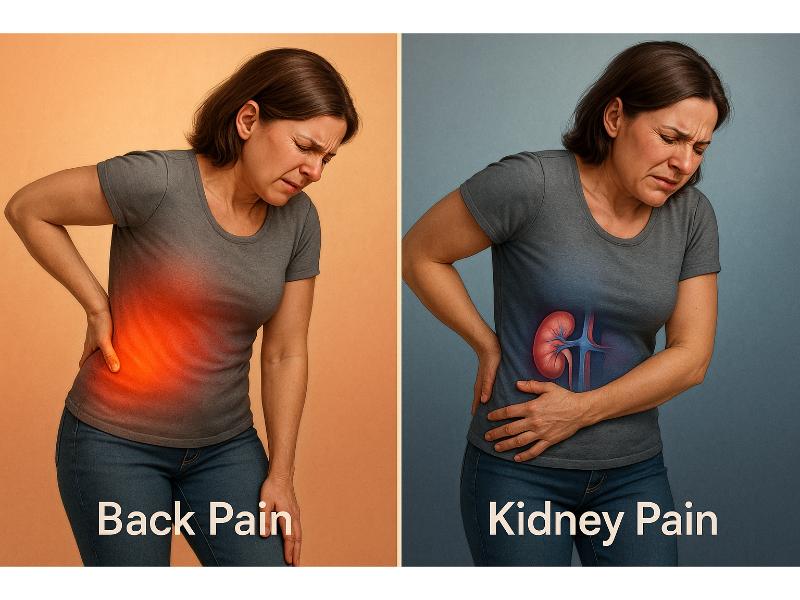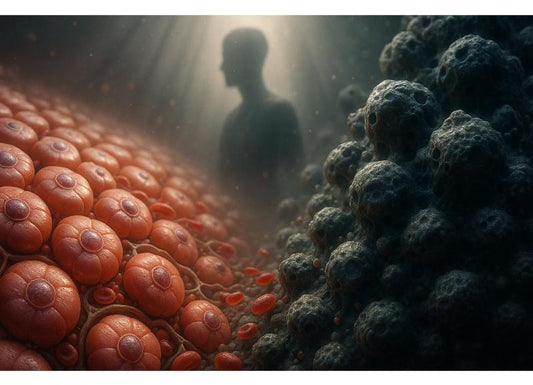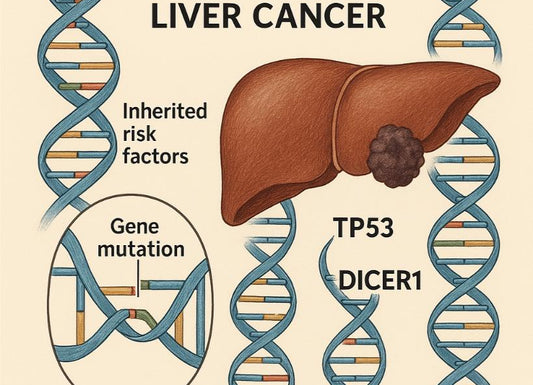Kidney Pain vs Back Pain: Telling the Difference
 Written By
Jaclyn P. Leyson-Azuela, RMT, MD, MPH
Written By
Jaclyn P. Leyson-Azuela, RMT, MD, MPH

A sharp pain experienced in your lower back or side raises a very important point: “kidney pain vs back pain”. Knowing the difference between these two matters for your health and treatment. Both types of pain can feel similar at first. But understanding the key differences helps you respond correctly and get the right care.
This article will explore things you need to know about kidney pain or back pain. You will get insights on how to differentiate so it won’t trigger unnecessary anxiety. You can find solace in knowing that you’re not alone in this plight.
Key Insights
-
Kidney pain occurs in the flank area, which is the space between your ribs and hip on either side of your spine, and often radiates to your lower belly or groin.
-
Back pain is centered along your spine and may spread to your lower back muscles, often worsening or improving with movement or specific positions.
-
Kidney pain is often accompanied by symptoms that back pain rarely causes, such as changes in urination, nausea, fever, or blood in the urine.
-
Location is key, as kidney pain rarely improves with position changes, while back pain often fluctuates based on how you sit, stand, or lie down.
-
Seek urgent medical help if kidney pain is accompanied by a high fever, severe nausea, inability to urinate, or blood in the urine.
-
Long-term kidney conditions can cause a persistent, dull ache, which differs from the sharp pain associated with kidney stones or infections.
What Are the Basics Kidney Pain vs Back Pain Basics?
Knowing the differences between kidney and back pain starts with understanding where this organ sits in your body. It also helps to know how they signal problems. Your kidneys rest behind the organs of your belly. They sit tucked under your ribcage on both sides of your spine.
On the other hand, back pain may come from muscles, ligaments, discs, or bones in your spine.
The pain patterns, triggers, and other symptoms create different hallmark signatures. These will help doctors and you identify the source. Back pain usually responds to movement and position changes. Physical therapy approaches often help too. Kidney pain comes from problems inside the organ or upon irritation of the nearby tissues. It requires specific and different treatments that focus on the kidney condition causing the pain.

Is it kidney pain or back pain?
Kidney pain feels different than back pain in several key ways. Kidney pain usually stays the same no matter how you position your body or specifically move. You might feel it as a deep, aching sensation in your flank area that doesn’t change when you bend over, stand up, or lie down.
Back pain often changes with your activities and positions. Sitting may make it worse, while lying down may bring relief. Physical movements like bending, twisting, or lifting usually affect how much your back hurts. The pain may even shoot down your leg, which is known as sciatica, or spread across your lower back muscles.
The timing also differs. Kidney pain can start suddenly with infections or stones. But, it may develop rather slowly for chronic or long-term conditions. Back pain often follows the following triggers:
-
Physical activity
-
Poor posture
-
Specific movements that strain your spine and nearby muscles
How to tell kidney pain vs back pain by symptoms?
Changes in urination provide the most reliable clue. You might notice the following symptoms:
-
Burning sensation when you urinate
-
Frequent urges to urinate
-
Cloudy to bloody urine
-
Trouble starting to urinate
Body-wide symptoms often come with kidney pain but rarely happen with back problems. The following symptoms generally suggest that your kidneys need attention:
-
Fever
-
Chills
-
Nausea
-
Vomiting
-
Feeling generally sick
Back pain doesn’t cause these whole-body responses unless you have a serious spinal infection.
Also, how the pain feels provides another clue. Kidney pain often feels like a deep, constant ache or sharp, cramping waves (especially for kidney stones). Back pain may feel like muscle tension, sharp stabbing with movement, or burning nerve pain that travels down your legs.
Where the pain occurs offers the clearest difference. Put your hands on your lower ribs on either side of your spine, this flank area is where kidney pain usually happens. Back pain centers more along your spine and spreads sideways across your lower back muscles.
When is it back pain vs kidney pain?

Back pain becomes the likely cause when your pain clearly connects to physical activities or positions. Did you lift something heavy yesterday, sleep in an awkward position, or sit at your desk for hours without moving? These situations usually produce back pain rather than kidney problems.
How you move reveals important information. Back pain often improves with gentle stretching, heat, or finding the right position to rest. Kidney pain stays stubbornly the same no matter what position you try or how you move your body.
Past episodes matter too. Have you felt similar pain before during times of physical strain or poor posture? If yes, back pain seems more likely. Kidney pain episodes usually connect to other health factors like dehydration, infections, or dietary choices rather than physical activity.
Your age also plays a likelihood. Young adults more often have back pain from lifestyle factors, sports, or work activities. Kidney stones and infections can affect any age. But certain kidney conditions become more common as people get older.
What Are the Symptoms and Causes of Kidney Pain?
Kidney pain comes from various conditions that affect these vital organs. Your kidneys filter waste from your blood and make urine. Understanding what causes kidney pain helps you know when this type of pain needs immediate medical attention and when you might manage it with supportive care.
How intense the pain is and what other symptoms you have vary greatly depending on what’s causing the problem. Kidney stones create severe, wave-like pain that can literally bring you to your knees. Kidney infections produce more constant, aching pain along with fever and urinary symptoms. Long-term kidney disease might cause only mild, ongoing discomfort until late stages.
Why do kidneys hurt?
Kidneys hurt when something interferes with their normal function or structure. Kidney stones cause the most painful type of pain. These mineral deposits form in your kidneys and create intense pain when they move through your urinary tract. The stones can block urine flow, causing pressure to build up behind the blockage.
Infections in your kidneys cause pain through swelling of kidney tissues. This condition is called pyelonephritis. Here, the bacteria travel up from your bladder to your kidneys, creating an infection that makes organs tender and painful. Urinary tract infections that spread to the kidneys become very serious.
Kidney disease creates pain through various means. Polycystic kidney disease causes cysts to grow and stretch kidney tissues. Long-term kidney disease might produce pain as kidneys slowly lose function and develop scarring. Sudden kidney injury from medications, dehydration, or other causes can also create discomfort.
Kidney cancer sometimes causes pain, though early stages often produce no symptoms. Blood clots in the kidney blood vessels, kidney abscesses, and certain autoimmune conditions affecting the kidneys can also create pain symptoms.
What Are the Symptoms of Kidney Pain?
Kidney pain symptoms go beyond just the discomfort itself. Flank pain is the main symptom, which is characterized as a deep, achy feeling in the area between your ribs and hip bone on one or both sides. This pain may spread forward to your lower belly or down toward your groin area.
Urinary symptoms almost always come with kidney pain. This includes:
-
Burning or stinging sensation when you urinate
-
Frequent urges to urinate even when the bladder isn’t full
-
Trouble starting to urinate
-
May only urinate small amounts at a time
-
Blood in the urine that may appear pink, red, or cola-colored
Body-wide symptoms show your body’s response to kidney problems. Fever and chills suggest infection, while nausea and vomiting commonly happen with kidney stones or severe infections. You may feel generally unwell, tired, or experience decreased appetite.
Changes in how you urinate provide important clues. You may make much less urine than normal or find yourself urinating much more often than usual. Foamy or cloudy urine can mean protein or infection, while strong-smelling urine may suggest concentrated urine or infection.
When to seek help for kidney pain?

Kidney pain needs medical evaluation sooner rather than later, especially when certain warning signs appear, such as:
-
High fever
-
Severe pain
-
Blood in urine
-
Inability to urinate
-
Major changes in urinary pattern
-
Nausea and vomiting
Fever with kidney pain suggests infection that needs quick antibiotic treatment to prevent complications. High fever (over 101°F) with kidney pain becomes a medical emergency.
Severe pain that doesn’t respond to over-the-counter pain medications or greatly interferes with your daily activities needs immediate medical attention. Kidney stone pain often reaches this severity level and may require prescription pain management or procedures to remove or break up the stones.
Urinary symptoms combined with kidney pain need evaluation. Blood in urine, inability to urinate, or major changes in urination patterns requiring medical assessment. Ongoing nausea and vomiting that prevents you from keeping fluids down also requires prompt care.
Long-term or returning kidney pain needs evaluation even when it’s not severe. This pattern might show underlying kidney disease or conditions that benefit from early treatment to prevent progression.
What Are Kidney Pain Emergencies?
Kidney pain emergencies require immediate emergency room evaluation and can't wait for regular doctor appointments. High fever (102°F or higher) with kidney pain and chills shows a serious kidney infection that could spread to your bloodstream if not treated quickly.
Complete inability to urinate with kidney pain suggests a complete blockage that can damage your kidneys permanently if not relieved quickly. Severe dehydration from ongoing vomiting combined with kidney pain also requires emergency treatment with IV fluids.
Signs of sepsis along with kidney pain show a life-threatening infection. These signs include confusion, rapid heartbeat, difficulty breathing, or extreme weakness. Severe bleeding in urine that makes it appear bright red requires immediate evaluation.
Kidney stone pain that's so severe you can't function becomes an emergency situation, especially when combined with fever or inability to urinate. These require immediate medical intervention.
What Are Chronic Kidney Conditions and Pain?
Chronic kidney conditions create different pain patterns than sudden kidney problems like stones or infections. These ongoing conditions often produce more subtle, ongoing discomfort. This differs from the intense, sudden pain that comes with kidney stones or sudden infections. Some of the chronic kidney conditions include:
-
Chronic kidney disease
-
Diabetic kidney disease
-
High blood pressure kidney disease
-
Glomerulonephritis
-
Interstitial nephritis
-
Kidney cancer
Chronic kidney disease affects millions of people. It can cause mild, constant aching in the flank area as kidney function slowly declines. Polycystic kidney disease creates pain as fluid-filled cysts grow and stretch kidney tissues over time. Autoimmune kidney diseases like lupus nephritis can cause occasional pain flares along with other symptoms.
Diabetic kidney disease usually doesn't cause major pain until late stages. This is when complications might develop. High blood pressure affecting the kidneys also rarely causes pain until kidney damage becomes severe.
Is back pain an indication of kidney cancer?
No, back pain alone is not an indication of kidney cancer. Other symptoms must be present like gradual muscle weakness associated with back pain. Most kidney cancers produce no symptoms in early stages. Advanced kidney cancer might cause back pain when tumors grow large enough to press on nearby tissues. It can also cause back pain when cancer spreads to bones in the spine.
Kidney cancer symptoms more commonly include blood in urine, unexplained weight loss, tiredness, fever, and a mass you can feel in your side or back. Back pain from kidney cancer usually feels different from muscle-related back pain. It's usually constant. It doesn't improve when you change positions. It may get worse over time.
Most back pain comes from muscle and bone causes. These include muscle strain, disc problems, or arthritis rather than kidney cancer. However, ongoing back pain that doesn't respond to usual treatments needs medical evaluation. This is especially true when combined with other concerning symptoms like unexplained weight loss or blood in urine.
Risk factors for kidney cancer include:
-
Smoking
-
Obesity
-
High blood pressure
-
Certain genetic conditions
-
Exposure to certain chemicals
People with these risk factors who develop ongoing back pain should discuss their concerns with healthcare providers.

How to stop kidney pain?
Stopping kidney pain requires addressing the root cause rather than just masking the discomfort. Kidney stone pain might go away as stones pass naturally. But larger stones may need medical procedures. Kidney infection pain requires antibiotic treatment to eliminate the infection causing swelling.
Drinking fluids plays a crucial role in many kidney pain situations. Drinking plenty of water helps flush bacteria from your urinary system during infections and can help smaller kidney stones pass more easily. However, if you're vomiting or have certain kidney conditions, your doctor might recommend specific fluid limits.
Heat might provide some comfort for kidney pain, though it won't address the root cause. Warm compresses applied to your flank area can help ease discomfort while waiting for medical treatment or medications to take effect.
Position changes rarely help kidney pain as much as they help back pain, but some people find slight relief lying on their side or in certain positions. Activity changes might be necessary when kidney pain is severe, though gentle movement is usually better than complete bed rest.
What's the best medical pain reliever for kidneys?
Over-the-counter pain relievers can help manage kidney pain temporarily, but medication choice matters greatly when dealing with kidney problems. Acetaminophen (Tylenol) is generally the safest option for people with kidney pain, as it doesn't affect kidney function when used as directed.
NSAIDs like ibuprofen (Advil, Motrin) and naproxen (Aleve) should be avoided or used very carefully with kidney problems. These medications can reduce blood flow to the kidneys and potentially make kidney function worse, especially in people with existing kidney disease or dehydration.
Prescription pain medications might be necessary for severe kidney pain, particularly with kidney stones. Stronger pain relievers like tramadol, codeine, or other opioids may be prescribed for short-term use during sudden kidney stone episodes.
Prescription anti-nausea medications often become necessary with kidney pain, especially when kidney stones or infections cause ongoing nausea and vomiting. IV pain medications and IV fluids might be required in emergency situations when oral medications can't be kept down.
Kidney-specific treatments provide the most effective pain relief by addressing the root cause. Antibiotics for kidney infections, procedures to remove kidney stones, or medications to help stones pass target the root cause of pain rather than just symptoms.
If you want to keep track of your health, you should consider using at-home kidney test strips in between doctor consults.
Quick Summary Box
-
Kidney pain usually happens in your flank area and stays the same no matter how you change positions. Back pain centers along your spine and often changes with movement.
-
Urinary symptoms like burning, frequency, blood in urine, or changes in urination almost always come with kidney pain. These rarely happen with back problems.
-
Fever, nausea, and vomiting commonly happen with kidney pain. This is especially true with infections or stones. These rarely come with simple back pain.
-
Medical emergencies include kidney pain with high fever, inability to urinate, severe dehydration, or signs of serious infection requiring immediate treatment.
-
Long-term kidney conditions can cause ongoing, dull aching that feels different from sudden kidney stone pain or infections.
-
Treatment approaches differ greatly. Back pain often responds to physical therapy and position changes. Kidney pain requires medical treatment of the kidney conditions causing it.
References
Belyayeva, M., & Jeong, J. M. (2024). Acute pyelonephritis. National Library of Medicine ; StatPearls Publishing. https://www.ncbi.nlm.nih.gov/books/NBK519537/
Davis, D., & Vasudevan, A. (2020, November 15). Sciatica. Nih.gov; StatPearls Publishing. https://www.ncbi.nlm.nih.gov/books/NBK507908/
Flank pain Information | Mount Sinai - New York. (n.d.). Mount Sinai Health System. https://www.mountsinai.org/health-library/symptoms/flank-pain
John Hopkins Medicine. (2024). Chronic Kidney Disease. Www.hopkinsmedicine.org. https://www.hopkinsmedicine.org/health/conditions-and-diseases/chronic-kidney-disease
Jones, O. (2024). The Kidneys - Position - Structure - Vasculature - TeachMeAnatomy. Teachmeanatomy.info. https://teachmeanatomy.info/abdomen/viscera/kidney/
National Institute of Diabetes and Digestive and Kidney Diseases. (2019). What Is Polycystic Kidney Disease? | NIDDK. National Institute of Diabetes and Digestive and Kidney Diseases. https://www.niddk.nih.gov/health-information/kidney-disease/polycystic-kidney-disease/what-is-pkd
National Institute of Diabetes and Digestive and Kidney Diseases. (2020, January 26). Symptoms & Causes of Kidney Infection (Pyelonephritis) | NIDDK. National Institute of Diabetes and Digestive and Kidney Diseases. https://www.niddk.nih.gov/health-information/urologic-diseases/kidney-infection-pyelonephritis/symptoms-causes
National Library of Medicine. (2019). Kidney stones: Overview. Nih.gov; Institute for Quality and Efficiency in Health Care (IQWiG). https://www.ncbi.nlm.nih.gov/books/NBK348937/
Rectenwald, R. (2008). A case study of back pain and renal cell carcinoma. Journal of Chiropractic Medicine, 7(1), 24–27. https://doi.org/10.1016/j.jcme.2008.01.001

Jaclyn P. Leyson-Azuela, RMT, MD, MPH, is a licensed General Practitioner and Public Health Expert. She currently serves as a physician in private practice, combining clinical care with her passion for preventive health and community wellness.



